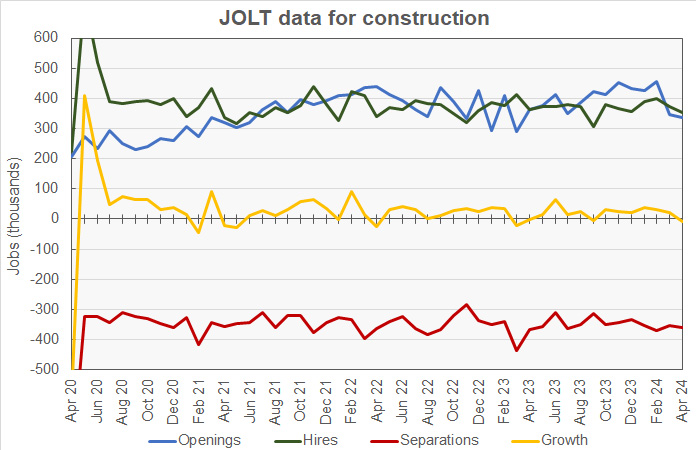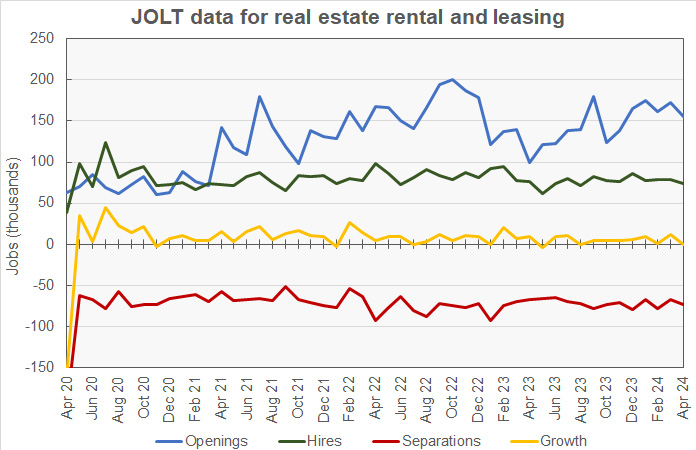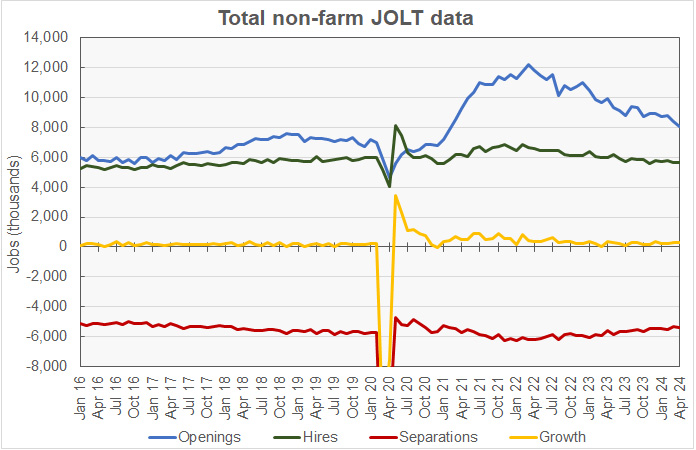The Job Openings and Labor Turnover (JOLT) report from the Bureau of Labor Statistics (BLS) said that, despite higher construction job openings, April saw a net loss of 8,000 construction jobs as quits jumped 27 percent.
Construction job openings lower but higher
The chart, below, shows the employment situation for the construction jobs market over the last 49 months. It shows a net loss of construction jobs for the month along with last month’s revised gain of 22,000 jobs. up from 15,000 jobs in the initial report.

In this month’s report, last month’s construction job openings figure was revised sharply higher, rising 26 percent (+72,000) to 346,000 openings. However, the preliminary job openings figure for April was reported to be down 8,000 openings from this level at 338,000 openings. Openings were reported to be 6.9 percent lower than last year’s level and were reported to represent 3.9 percent of construction employment plus job openings.
Hiring was reported to be down by 21,000 jobs in April from the prior month’s revised (+33,000) jobs figure at 353,000 new hires. The number of construction jobs that were filled in April was reported to be down 6.6 percent year-over-year.
Construction jobs total separations were reported to rise by 9,000 jobs from the prior month’s revised (+26,000) figure to 361,000 jobs.
Quits were reported to rise by 42,000 jobs from March’s revised (-1,000) figure to a level of 198,000 jobs. Quits represented 54.8 percent of separations for the month, up by 10.5 percentage points from the revised level of last month.
Layoffs were reported to fall by 24,000 from March’s revised (+33,000) figure to 154,000 jobs. “Other separations” which includes retirements and transfers, were reported to be down 10,000 at 9,000 jobs.
RERL job openings rate remains high
The chart, below, shows the employment situation for the real estate and rental and leasing (RERL) jobs category. Employment in this jobs category was reported to be unchanged for the month as hiring matched separations.

The number of job openings in the RERL category was reported to be 155,000 jobs at the end of April. This was down 18,000 job openings from the revised (-3,000) level of the month before. RERL job openings in April were 55.0 percent higher than the unusually low figure for April 2023. Job openings in the RERL category represent 5.8 percent of total employment plus job openings.
Hiring in April was reported to be up 5,000 jobs from March’s revised (-5,000) figure at 74,000 jobs. The hiring figure was 2.6 percent below the year-earlier level.
Total separations in the RERL jobs category in April were up by 7,000 from March’s unchanged figure at 74,000 jobs.
Quits were up by 5,000 from March’s revised (-3,000) figure at 38,000 jobs. Quits represented 51.4 percent of total separations in April. Layoffs were reported to rise by 2,000 from March’s revised (+3,000) figure to 28,000 jobs.
Overall job openings lower
The BLS reported that the number of job openings in April was 8.06 million. This was reported to be down 296,000 openings month-over-month. In addition, the openings figure for March was revised lower by 133,000 openings, so the decline is steeper than the headline figure would suggest. Job openings were down 1,845,000 openings from the year-ago level.
Hiring was reported to be down from last month’s revised (+117,000) figure for the economy as a whole, falling 23,000 to a level of 5.64 million hires. Total separations rose 42,000 from last month’s revised (+130,000) figure to a level of 5.37 million. Within total separations, quits were reported to rise 2.9 percent while layoffs fell 5.4 percent. Quits represented 65.3 percent of total separations for the month.
The April job openings figure represents 4.8 percent of total employment plus job openings. For comparison, the unemployment rate in April was reported to be 3.9 percent and 6.5 million people were unemployed. Another 5.6 million people said that they would like a job but were not counted as being in the labor force since they were not actively seeking employment.
The excess of hiring over separations in the April JOLT report implies an employment increase of 268,000 jobs for the month. Last month’s employment increase was revised to 287,000 jobs, down by 13,000 jobs from the gain reported last month.
Of those leaving their jobs in April, 3.51 million quit voluntarily, while 1.52 million people were involuntarily separated from their jobs. The remainder of people leaving their jobs left for other reasons, such as retirements or transfers. The portion of people quitting their jobs was up 0.1 percentage point from last month’s figure at 2.2 percent of the labor force. The involuntary separations rate was unchanged from last month’s figure at 1.0 percent.
Total non-farm JOLT data since January 2016 is shown in the chart, below.

The numbers given in the JOLT report are seasonally adjusted and are subject to revision. It is common for adjustments to be made in subsequent reports, particularly to the data for the most recent month. The full current JOLT report can be found here.
Comparing the reports
The US labor market is very dynamic with many people changing jobs in any given month. The JOLT report documents this dynamism by providing details about job openings, hiring and separations. However, it does not break down the jobs market into as fine categories as does the Employment Situation Report, which provides data on total employment and unemployment. For example, while the Employment Situation Report separates residential construction from other construction employment, the JOLT report does not. The Employment Situation Report separates residential property managers from other types of real estate and rental and leasing professionals, but the JOLT report does not. However, the JOLT report provides a look at what is driving the employment gains (or losses) in broad employment categories.













